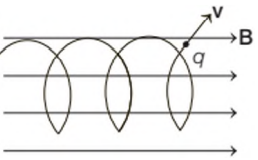Lorentz Force and Its Effects
A charged particle moving in an external magnetic field experiences a force, which is called Lorentz force, i.e. `F=q(v xx B)`,
where `q` is the charge on the particle and v is the velocity of the particle. The direction of the force is given by the cross product of velocity vector and magnetic field vector at any time.
The charge particle travels in a special trajectory called helical path. Because the force is always perpendicular to the velocity vector, the magnetic field can do no work on an isolate charge. Hence, the linear velocity always remains the same.

The force on a charged particle moving with a velocity `v` in a magnetic field B is not
Options:
(a) perpendicular to both `v and B`
(b) maximum, if `v` is perpendicular to `B`
(c) maximum, if `v` is parallel to `B`
(d) zero, if `v` is parallel to `B`